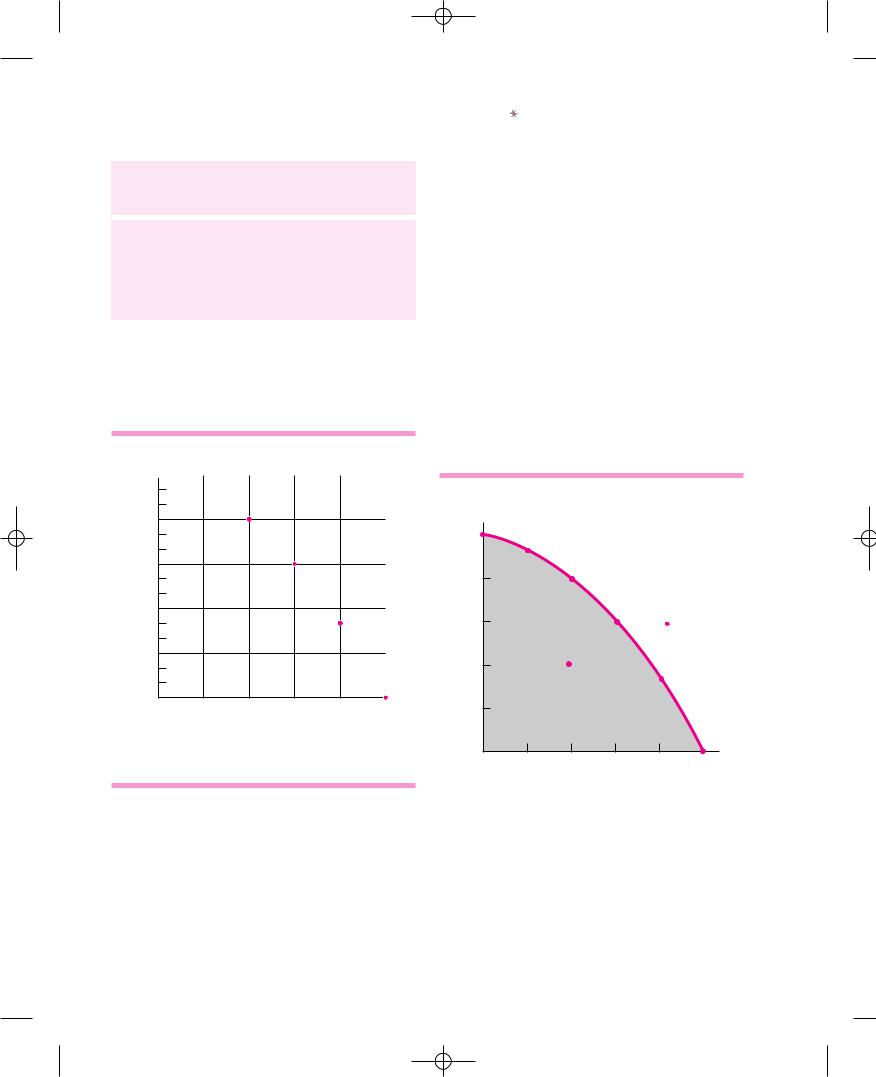
chapter1
.pdf
sam14885_ch01_001 10/18/00 12:37 AM Page 1
PA
RT
O
N
E
Basic Concepts

sam14885_ch01_002 10/18/00 12:37 AM Page 2

sam14885_ch01_003 10/18/00 12:38 AM Page 3
INTRODUCTION
C H A P T E R
1
The Fundamentals of
Economics
The Age of Chivalry is gone; that of sophisters, economists, and calculators has succeeded.
Edmund Burke
you |
probably wondering, Why study eco- |
do |
a number of reasons. |
|
because they hope to make money. |
|
they will be considered illiterate if they |
|
laws of supply and demand. |
interested in learning about how computinformation revolution are shaping our sowhy inequality in the distribution of income United States has risen so sharply in recent
For Whom the Bell Tolls
these reasons, and many more, make good sense. Still, as we have come to realize, there is one overriding reason for learning the basic lessons of economics: All your life—from cradle to grave and beyond—you will run up against the brutal truths of economics. As a voter, you will make decisions on issues that cannot be understood until you have mastered the rudiments of this subject. Without a study of economics, you cannot be fully informed about international trade, the economic impact of the Internet, or the trade-off between infla-
tion and unemployment.
Choosing your life’s occupation is the most important economic decision you will make. Your future depends not only on your own abilities but also on how economic forces beyond your control affect your wages. Also, your knowledge of economics may help
invest the nest egg you save from your earnings. Of course, studying economics canmake you a genius. But without economics
dice of life are loaded against you.
There is no need to belabor the point. We will find that, in addition to being useful, is a fascinating field in its own right. Gen-
students, often to their surprise, have discovstimulating economics can be.
3

sam14885_ch01_ 9/5/00 2:58 PM Page 4
4 |
CHAPTER 1 |
THE FUNDAMENTALS OF ECONOMICS |
SCARCITY AND EFFICIENCY:
THE TWIN THEMES OF ECONOMICS
What is economics? Over the last half-century, the study of economics has expanded to include a vast range of topics. What are the major definitions of these growing subjects?1 The important ones are that economics
●analyzes how a society’s institutions and technology affect prices and the allocation of resources among different uses.
●explores the behavior of the financial markets, including interest rates and stock prices.
●examines the distribution of income and suggests ways that the poor can be helped without harming the performance of the economy.
●studies the business cycle and examines how monetary policy can be used to moderate the swings in unemployment and inflation.
●studies the patterns of trade among nations and analyzes the impact of trade barriers.
●looks at growth in developing countries and proposes ways to encourage the efficient use of resources.
●asks how government policies can be used to pursue important goals such as rapid economic growth, efficient use of resources, full employment, price stability, and a fair distribution of income.
This list is a good one, yet you could extend it many times over. But if we boil down all these definitions, we find one common theme:
Economics is the study of how societies use scarce resources to produce valuable commodities and distribute them among different people.
Behind this definition are two key ideas in economics: that goods are scarce and that society must use its resources efficiently. Indeed, economics is an important subject because of the fact of scarcity and the desire for efficiency.
Consider a world without scarcity. If infinite quantities of every good could be produced or if hu-
1This list contains several specialized terms from economics. To master the subject, you will need to understand its vocabulary. If you are not familiar with a particular word or phrase, you should consult the Glossary at the back of this book. The Glossary contains most of the major technical economic terms used in this book. All terms printed in boldface are defined in the Glossary.
man desires were fully satisfied, what would be the consequences? People would not worry about stretching out their limited incomes because they could have everything they wanted; businesses would not need to fret over the cost of labor or health care; governments would not need to struggle over taxes or spending or pollution because nobody would care. Moreover, since all of us could have as much as we pleased, no one would be concerned about the distribution of incomes among different people or classes.
In such an Eden of affluence, all goods would be free, like sand in the desert or seawater at the beach. All prices would be zero, and markets would be unnecessary. Indeed, economics would no longer be a useful subject.
But no society has reached a utopia of limitless possibilities. Ours is a world of scarcity, full of economic goods. A situation of scarcity is one in which goods are limited relative to desires. An objective observer would have to agree that, even after two centuries of rapid economic growth, production in the United States is simply not high enough to meet everyone’s desires. If you add up all the wants, you quickly find that there are simply not enough goods and services to satisfy even a small fraction of everyone’s consumption desires. Our national output would have to be many times larger before the average American could live at the level of the average doctor or big-league baseball player. Moreover, outside the United States, particularly in Africa and Asia, hundreds of millions of people suffer from hunger and material deprivation.
Given unlimited wants, it is important that an economy make the best use of its limited resources. That brings us to the critical notion of efficiency. Efficiency denotes the most effective use of a society’s resources in satisfying people’s wants and needs. By contrast, consider an economy with unchecked monopolies or unhealthy pollution or unwarranted government interferences. Such an economy may produce less than would be possible without these factors, or it may produce a disorted bundle of goods that leaves consumers worse off than they otherwise could be—either situation is an inefficient allocation of resources.
In economics, we say that an economy is producing efficiently when it cannot make anyone economically better off without making someone else worse off.

sam14885_ch01_ 9/5/00 2:58 PM Page 5
THE LOGIC OF ECONOMICS
The essence of economics is to acknowledge the reality of scarcity and then figure out how to organize society in a way which produces the most efficient use of resources. That is where economics makes its unique contribution.
Microeconomics and Macroeconomics
Adam Smith is usually considered the founder of the field of microeconomics, the branch of economics which today is concerned with the behavior of individual entities such as markets, firms, and households. In The Wealth of Nations (1776), Smith considered how individual prices are set, studied the determination of prices of land, labor, and capital, and inquired into the strengths and weaknesses of the market mechanism. Most important, he identified the remarkable efficiency properties of markets and saw that economic benefit comes from the self-inter- ested actions of individuals. These remain important issues today, and while the study of microeconomics has surely advanced greatly since Smith’s day, he is still cited by politicians and economists alike.
The other major branch of our subject is macroeconomics, which is concerned with the overall performance of the economy. Macroeconomics did not even exist in its modern form until 1935, when John Maynard Keynes published his revolutionary General Theory of Employment, Interest and Money. At the time, England and the United States were still stuck in the Great Depression of the 1930s, with over one-quar- ter of the American labor force unemployed. In his new theory Keynes developed an analysis of what causes business cycles, with alternating spells of high unemployment and high inflation. Today, macroeconomics examines a wide variety of areas, such as how total investment and consumption are determined, how central banks manage money and interest rates, what causes international financial crises, and why some nations grow rapidly while others stagnate. Although macroeconomics has progressed far since his first insights, the issues addressed by Keynes still define the study of macroeconomics today.
The two branches—microeconomics and macro- economics—converge to form the core of modern economics.
THE LOGIC OF ECONOMICS
5
vesting, persuading, and threatening. The ultimate purpose of economic science and of this text is to understand this complex undertaking. How do economists go about their task?
Economists use the scientific approach to understand economic life. This involves observing economic affairs and drawing upon statistics and the historical record. For complex phenomena like the impacts of budget deficits or the causes of inflation, historical research has provided a rich mine of insights.
Often, economics relies upon analyses and theories. Theoretical approaches allow economists to make broad generalizations, such as those concerning the advantages of international trade and specialization or the disadvantages of tariffs and quotas.
In addition, economists have developed a specialized technique known as econometrics, which applies the tools of statistics to economic problems. Using econometrics, economists can sift through mountains of data to extract simple relationships.
Budding economists must also be alert to common fallacies in economic reasoning. Because economic relationships are often complex, involving many different variables, it is easy to become confused about the exact reason behind events or the impact of policies on the economy. The following are some of the common fallacies encountered in economic reasoning:
●The post hoc fallacy. The first fallacy involves the inference of causality. The post hoc fallacy occurs when we assume that, because one event occurred be-
fore another event, the first event caused the second event.2 An example of this syndrome occurred in
the Great Depression of the 1930s in the United States. Some people had observed that periods of business expansion were preceded or accompanied by rising prices. From this, they concluded that the appropriate remedy for depression was to raise wages and prices. This idea led to a host of legislation and regulations to prop up wages and prices in an inefficient manner. Did these measures promote economic recovery? Almost surely not. Indeed, they probably slowed recovery, which did not occur until total spending
Economic life is an enormously complicated hive of activity, with people buying, selling, bargaining, in-
2“Post hoc” is shorthand for post hoc, ergo propter hoc. Translated from the Latin, the full expression means “after this, therefore necessarily because of this.”

sam14885_ch01_ 9/5/00 2:58 PM Page 6
6 |
CHAPTER 1 |
THE FUNDAMENTALS OF ECONOMICS |
began to rise as the government increased military spending in preparation for World War II.
●Failure to hold other things constant. A second pitfall is failure to hold other things constant when thinking about an issue. For example, we might want to know whether raising tax rates will raise or lower tax revenues. Some people have put forth the seductive argument that we can eat our fiscal cake and have it too. They argue that cutting tax rates will at the same time raise government revenues and lower the budget deficit. They point to the Kennedy-Johnson tax cuts of 1964, which lowered tax rates sharply and were followed by an increase in government revenues in 1965. Hence, they argue, lower tax rates produce higher revenues.
What is wrong with this reasoning? This argument overlooks the fact that the economy grew from 1964 to 1965. Because people’s incomes grew during that period, government revenues also grew, even though tax rates were lower. Careful studies indicate that revenues would have been even higher in 1965 had tax rates not been lowered in 1964. Hence, this analysis fails to hold other things (namely, total incomes) constant.
Remember to hold other things constant when you are analyzing the impact of a variable on the economic system.
●The fallacy of composition. Sometimes we assume that what holds true for part of a system also holds true for the whole. In economics, however, we often find that the whole is different from the sum of the parts. When you assume that what is true for the part is also true for the whole, you are committing the fallacy of composition.
Here are some true statements that might surprise you if you ignored the fallacy of composition: (1) If one farmer has a bumper crop, she has a higher income; if all farmers produce a record crop, farm incomes will fall. (2) If one person receives a great deal more money, that person will be better off; if everyone receives a great deal more money, the society is likely to be worse off. (3) If a high tariff is put on the product of a particular industry, the producers in that industry are likely to profit; if high tariffs are put on all industries, most producers and consumers will be worse off.
These examples contain no tricks or magic. Rather, they are the results of systems of interacting individuals. Often the behavior of the aggregate looks very different from the behavior of individual people.
We mention these fallacies only briefly in this introduction. Later, as we introduce the tools of economics, we will provide examples of how inattention to the logic of economics can lead you to false and sometimes costly errors. When you reach the end of this book, you can look back to see why each of these paradoxical examples is true.
COOL HEADS AT THE SERVICE OF WARM HEARTS
Economics has, over the last century, grown from a tiny acorn into a mighty oak. Under its spreading branches we find explanations of the gains from international trade, advice on how to reduce unemployment and inflation, formulas for investing your retirement funds, and even proposals for selling the rights to pollute. Throughout the world, economists are laboring to collect data and improve our understanding of economic trends.
You might well ask, What is the purpose of this army of economists measuring, analyzing, and calculating? The ultimate goal of economic science is to improve the living conditions of people in their everyday lives. Increasing the gross domestic product is not just a numbers game. Higher incomes mean good food, warm houses, and hot water. They mean safe drinking water and inoculations against the perennial plagues of humanity.
Higher incomes mean even more. They allow governments to build schools so that young people can learn to read and develop the skills necessary to invent new technologies like artificial intelligence. As incomes rise further, nations can afford deep scientific inquiries into biology and discover still more vaccines against still more diseases. With the resources freed up by economic growth, talented artists have the opportunity to write poetry and compose music, while others have the leisure time to read, to listen, and to perform. Although there is no single pattern of economic development, and the evolution of culture will differ around the world, freedom from hunger, disease, and the elements is a universal human aspiration.

sam14885_ch01_007 10/18/00 12:38 AM Page 7
COOL HEADS AT THE SERVICE OF WARM HEARTS
But centuries of human history also show that warm hearts alone will not feed the hungry or heal the sick. A free and efficient market will not necessarily produce a distribution of income that is socially acceptable. Determining the best route to economic progress or an equitable distribution of society’s output requires cool heads, ones that objectively weigh the costs and benefits of different approaches, trying as hard as humanly possible to keep the analysis free from the taint of wishful thinking. Sometimes, economic progress will require shutting down an outmoded factory. Sometimes, as when the formerly socialist countries adopted market principles, things get worse before they get better. Choices are particularly difficult in the field of health care, where limited resources literally involve life and death.
You may have heard the saying, “From each according to his ability, to each according to his need.” Governments have learned that no society can long operate solely on this utopian principle. To maintain a healthy economy, governments must preserve incentives for people to work and to save. Societies can support the unemployed for a while, but when unemployment insurance covers too much for too long, people come to depend upon the government and stop looking for work. If they begin to believe that the government owes them a living, this may dull the sharp edge of enterprise. Just because government programs derive from lofty purposes does not mean that they should be pursued without care and efficiency.
Society must find the right balance between the discipline of the market and the compassion of government social programs. By using cool heads to inform our warm hearts, economic science can do its part in ensuring a prosperous and just society.
B. THE THREE OF ECONOMIC ORGANIZATION
Every human society—whether it is an advanced in-
dustrial nation, a centrally |
economy, or an |
isolated tribal nation— |
confront and resolve |
three fundamental economic problems. Every society must have a way of determining what commodi-
7
ties are produced, how these goods are made, and for whom they are produced.
Indeed, these three fundamental questions of economic organization—what, how, and for whom— are as crucial today as they were at the dawn of human civilization. Let’s look more closely at them:
●What commodities are produced and in what quantities? A society must determine how much of each of the many possible goods and services it will make and when they will be produced. Will we produce pizzas or shirts today? A few high-quality shirts or many cheap shirts? Will we use scarce resources to produce many consumption goods (like pizzas)? Or will we produce fewer consumption goods and more investment goods (like pizza-making machines), which will boost production and consumption tomorrow.
●How are goods produced? A society must determine who will do the production, with what resources, and what production techniques they will use. Who farms and who teaches? Is electricity generated from oil, from coal, or from the sun? Will factories be run by people or robots?
●For whom are goods produced? Who gets to eat the fruit of economic activity? Is the distribution of income and wealth fair and equitable? How is the national product divided among different households? Are many people poor and a few rich? Do high incomes go to teachers or athletes or autoworkers or Internet entrepreneurs? Will society provide minimal consumption to the poor, or must people work if they are to eat?
Positive economics versus normative economics
In thinking about economic questions, we must distinguish questions of fact from questions of fairness. Positive economics describes the facts of an economy, while normative eco-
nomics involves value judgments.
Positive economics deals with questions such as: Why do doctors earn more than janitors? Does free trade raise or lower the wages of most Americans? What is the impact of computers on productivity? Although these are difficult questions to answer, they can all be resolved by

sam14885_ch01_ 9/5/00 2:58 PM Page 8
8 |
CHAPTER 1 |
THE FUNDAMENTALS OF ECONOMICS |
reference to analysis and empirical evidence. That puts them in the realm of positive economics.
Normative economics involves ethical precepts and norms of fairness. Should poor people be required to work if they are to get government assistance? Should unemployment be raised to ensure that price inflation does not become too rapid? Should the United States break up Microsoft because it has violated the antitrust laws? There are no right or wrong answers to these questions because they involve ethics and values rather than facts. They can be resolved only by political debate and decisions, not by economic analysis alone.
MARKET, COMMAND, AND
MIXED ECONOMIES
What are the different ways that a society can answer the questions of what, how, and for whom? Different societies are organized through alternative economic systems, and economics studies the various mechanisms that a society can use to allocate its scarce resources.
We generally distinguish two fundamentally different ways of organizing an economy. At one extreme, government makes most economic decisions, with those on top of the hierarchy giving economic commands to those further down the ladder. At the other extreme, decisions are made in markets, where individuals or enterprises voluntarily agree to exchange goods and services, usually through payments of money. Let’s briefly examine each of these two forms of economic organization.
In the United States and most democratic countries, most economic questions are solved by the market. Hence their economic systems are called market economies. A market economy is one in which individuals and private firms make the major decisions about production and consumption. A system of prices, of markets, of profits and losses, of incentives and rewards determines what, how, and for whom. Firms produce the commodities that yield the highest profits (the what) by the techniques of production that are least costly (the how). Consumption is determined by individuals’ decisions about how to spend the wages and property incomes generated by their labor and property ownership (the for whom). The extreme case of a market economy, in which the
government keeps its hands off economic decisions, is called a laissez-faire economy.
By contrast, a command economy is one in which the government makes all important decisions about production and distribution. In a command economy, such as the one which operated in the Soviet Union during most of the twentieth century, the government owns most of the means of production (land and capital); it also owns and directs the operations of enterprises in most industries; it is the employer of most workers and tells them how to do their jobs; and it decides how the output of the society is to be divided among different goods and services. In short, in a command economy, the government answers the major economic questions through its ownership of resources and its power to enforce decisions.
No contemporary society falls completely into either of these polar categories. Rather, all societies are mixed economies, with elements of market and command. There has never been a 100 percent market economy (although nineteenth-century England came close).
Today most decisions in the United States are made in the marketplace. But the government plays an important role in overseeing the functioning of the market; governments pass laws that regulate economic life, produce educational and police services, and control pollution. Most societies today operate mixed economies.
C. SOCIETY’S TECHNOLOGICAL
POSSIBILITIES
Every gun that is |
every warship |
launched, every rocket fired signifies, in |
|
the final sense, a theft from those who |
|
hunger |
are not fed. |
President |
D. Eisenhower |
Each economy has a |
of limited resources— |
labor, technical |
factories and tools, land, |
energy. In deciding |
how things should be |
produced, the economy |
reality deciding how to |

sam14885_ch01_ 9/5/00 2:58 PM Page 9
INPUTS AND OUTPUTS
allocate its resources among the thousands of different possible commodities and services. How much land will go into growing wheat? Or into housing the population? How many factories will produce computers? How many will make pizzas? How many children will grow up to play professional sports or to be professional economists or to program computers?
Faced with the undeniable fact that goods are scarce relative to wants, an economy must decide how to cope with limited resources. It must choose among different potential bundles of goods (the what), select from different techniques of production (the how), and decide in the end who will consume the goods (the for whom).
INPUTS AND OUTPUTS
To answer these three questions, every society must make choices about the economy’s inputs and outputs. Inputs are commodities or services that are used to produce goods and services. An economy uses its existing technology to combine inputs to produce outputs. Outputs are the various useful goods or services that result from the production process and are either consumed or employed in further production. Consider the “production” of pizza. We say that the eggs, flour, heat, pizza oven, and chef’s skilled labor are the inputs. The tasty pizza is the output. In education, the inputs are the time of the faculty, the laboratories and classrooms, the textbooks, and so on, while the outputs are informed, productive, and well-paid citizens.
Another term for inputs is factors of production. These can be classified into three broad categories: land, labor, and capital.
●Land—or, more generally, natural resources— represents the gift of nature to our productive processes. It consists of the land used for farming or for underpinning houses, factories, and roads; the energy resources that fuel our cars and heat our homes; and the nonenergy resources like copper and iron ore and sand. In today’s congested world, we must broaden the scope of natural resources to include our environmental resources, such as clean air and drinkable water.
●Labor consists of the human time spent in pro- duction—working in automobile factories, tilling
9
the land, teaching school, or baking pizzas. Thousands of occupations and tasks, at all skill levels, are performed by labor. It is at once the most familiar and the most crucial input for an advanced industrial economy.
●Capital resources form the durable goods of an economy, produced in order to produce yet other goods. Capital goods include machines, roads, computers, hammers, trucks, steel mills, automobiles, washing machines, and buildings. As we will see later, the accumulation of specialized capital goods is essential to the task of economic development.
Restating the three economic problems in terms of inputs and outputs, a society must decide (1) what outputs to produce, and in what quantity; (2) how to produce them—that is, by what techniques inputs should be combined to produce the desired outputs; and (3) for whom the outputs should be produced and distributed.
THE PRODUCTION-POSSIBILITY FRONTIER
Societies cannot have everything they want. They are limited by the resources and the technology available to them. Take defense spending as an example. Countries must decide how much of their limited resources goes to their military and how much goes into other activities (such as new factories or education). Some countries, like Japan, allocate only 1 percent of their national output to their military. The United States spends 4 percent of its national output on defense, while a fortress economy like North Korea spends up to 20 percent of its national output on the military. The more output that goes for defense, the less there is available for consumption and investment.
Let us dramatize this choice by considering an economy which produces only two economic goods, guns and butter. The guns, of course, represent military spending, and the butter stands for civilian spending. Suppose that our economy decides to throw all its energy into producing the civilian good, butter. There is a maximum amount of butter that can be produced per year. The maximal amount of butter depends on the quantity and quality of the economy’s resources and the productive efficiency

sam14885_ch01_ 9/5/00 2:59 PM Page 10
10 |
CHAPTER 1 |
THE FUNDAMENTALS OF ECONOMICS |
Alternative Production Possibilities
|
Butter |
Guns |
Possibilities |
(millions of pounds) |
(thousands) |
A |
0 |
15 |
B |
1 |
14 |
C |
2 |
12 |
D |
3 |
9 |
E |
4 |
5 |
F |
5 |
0 |
TABLE 1-1. Limitation of Scarce Resources Implies the
Guns-Butter Tradeoff
Scarce inputs and technology imply that the production of guns and butter is limited. As we go from A to B . . . to F, we are transferring labor, machines, and land from the gun industry to butter and can thereby increase butter production.
produce 15,000 guns of a certain kind if no butter is produced.
These are two extreme possibilities. In between are many others. If we are willing to give up some butter, we can have some guns. If we are willing to give up still more butter, we can have still more guns.
A schedule of possibilities is given in Table 1-1. Combination F shows the extreme, where all butter and no guns are produced, while A depicts the opposite extreme, where all resources go into guns. In between—at E, D, C, and B—increasing amounts of butter are given up in return for more guns.
How, you might well ask, can a nation turn butter into guns? Butter is transformed into guns not physically but by the alchemy of diverting the economy’s resources from one use to the other.
We can represent our economy’s production possibilities more vividly in the diagram shown in
15 
A
 B
B
|
12 |
|
|
C |
|
|
(thousands) |
|
|
|
|
|
|
9 |
|
|
D |
|
|
|
|
|
|
|
|
||
|
|
|
|
|
|
|
Guns |
6 |
|
|
|
|
E |
|
|
|
|
|
|
|
|
3 |
|
|
|
|
|
|
|
|
|
|
|
F |
|
0 |
1 |
2 |
3 |
4 |
5 |
|
|
|
Butter (millions of pounds) |
|
|
|
FIGURE 1-1. The Production Possibilities in a Graph
This figure displays the alternative combinations of production pairs from Table 1-1.
with which they are used. Suppose 5 million pounds of butter is the maximum amount that can be produced with the existing technology and resources.
At the other extreme, imagine that all resources are instead devoted to the production of guns. Again, because of resource limitations, the economy can produce only a limited quantity of guns. For this example, assume that the economy can
The Production-Possibility Frontier
|
|
G |
|
|
|
15 |
A |
|
|
|
|
B |
|
|
|
12 |
C |
|
|
(thousands) |
|
|
||
9 |
D |
I |
||
|
||||
Guns |
6 |
U |
E |
|
|
|
|||
|
|
|
3
F
B
0 |
1 |
2 |
3 |
4 |
5 |
Butter (millions of pounds)
FIGURE 1-2. A Smooth Curve Connects the Plotted Points of the Numerical Production Possibilities
This frontier shows the schedule along which society can choose to substitute guns for butter. It assumes a given state of technology and a given quantity of inputs. Points outside the frontier (such as point I ) are infeasible or unattainable. Any point inside the curve, such as U, indicates that the economy has not attained productive efficiency, as is the case, for instance, when unemployment is high during severe business cycles.
